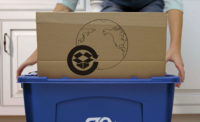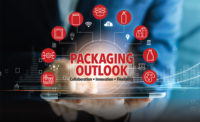Packaging Outlook 2020: Paperboard and Corrugated

Paperboard Packaging
Steady, stable, sustainable and innovative. These four words describe the paperboard packaging market today and, we forecast, for many years to come. As part of the Paperboard Packaging Council’s (PPC’s) industry data offering, we keep a pulse on economic trends that will affect the folding carton market. Following are just a few of the developments to expect in 2020.
Economic and Market Outlook 2020
According to the most recent data, folding carton demand will enjoy measured growth through 2023. The total value of U.S. carton shipments should climb from an estimated $8.5 billion in 2018 to $9.3 billion in 2023. Additionally, average values per ton, which dipped from 2015-2017 before recovering in 2018, are expected to grow by 1.7% over the forecast.
Drilling down, the paperboard packaging market should experience growth as well as challenges in various end-use market segments:
Growing Demand for Frozen Food: The frozen food market has struggled for many years as consumers trended toward healthier, on-the-go food options. However, demand has recently begun to thaw, with carton shipments on the rise.
Several factors have contributed to this resurgence in frozen food purchasing, including:
- Higher rates of employment — more work means less time at home for meal preparation, so consumers are reaching for quick and easy food options;
- Millennial lifestyles — younger consumers are waiting to create families and often do not take time to make fresh meals; and
- Dietary changes — the American public trends toward eating well, including options with higher amounts of protein and vegetables, and is more receptive to the increasingly healthier frozen options available today.
With all of these factors in mind, folding carton shipments to the frozen foods market are expected to grow at a healthy 1.2% per annum over the next five years.
Sustainability at Retail Carryout: With declining consumer sentiment toward single-use plastic packaging at carryout restaurants, sustainable and renewable paperboard packaging is poised to fill the gap.
A look at the top carryout chains in the U.S. is telling. McDonald’s plans to use renewable, recycled or certified sources for all packaging by 2025. Dunkin’ (Donuts) started eliminating polystyrene foam cups from its global supply chain in the spring of 2018, with a 2020 target date of completion. They are being replaced with double-walled paper cups. This step falls in line with the company’s commitments in the U.S. to have 80% of fiber-based packaging, certified by the Sustainable Forestry Initiative Standard, by the end of 2018. Most recently, Taco Bell announced it would ensure all of its packaging is recyclable or compostable by 2025.
Considering these shifts, and presumably more to come, folding carton shipments to retail carryout will be the fastest-growing end-use segment over the horizon, with growth estimated at around 1.7% between 2019 and 2023.
Changes in the Digital Marketplace: As the ecommerce marketplace continues to grow, packaging manufacturers will need to account for digital customers and their purchasing habits, especially in dry food and household supply markets.
People have grown accustomed to the digital retail model, and the acquisition of Whole Foods Market by Amazon has provided additional momentum. Beyond groceries, consumers are turning to e-commerce for home tools and appliances. Online shopping’s convenience, competitive prices and variety have all enhanced ecommerce sales.
This said, manufacturers might not necessarily find this beneficial. Ecommerce sales in the cereal and household supplies markets will limit the growth of folding carton shipments, increasing the share of corrugated boxes in the long run. Carton shipments to these sectors will likely contract over the next five years as packaging demands shift toward the needs of e-commerce rather than in-store shelves.
Opportunities for the Bold
How can paperboard packaging manufacturers take advantage of growth trends in the marketplace? Bold design can set them squarely apart from the crowd. Eye-catching exteriors and sustainable, recyclable construction are a strong starting point, but new ideas and innovative approaches to design can yield even greater benefits.
Each year, PPC holds the North American Paperboard Packaging Competition, not only to celebrate carton design but also to keep a pulse on the latest trends in the space. In our most recent competition, we saw many bold design elements like:
- Expanded digital printing capacities, including the ability to print, cut, and glue 24 unique SKUs in 24-48 hours every week
- A significant move away from plastic hi-cones and shrink-wrap to highly decorated carton-based multipack solutions for both bottles and canned drinks
- Novel and sustainable concepts like the “virtual window,” which substituted a plastic window for a descriptive graphic of the product inside
- Innovative packaging solutions designed to protect retail delivery food from tampering during transit.
New approaches inherently come with risk, but this could mean reward for the paperboard packaging industry going forward.
Insights here are from PPC’s “2019-20 Industry Outlook & Market Data Research Report.” For information about the Paperboard Packaging Council and the report, visit paperbox.org.
Corrugated Packaging
This year marks the Fibre Box Association’s (FBA) 80th Anniversary. Founded in 1940, the association has a long-standing heritage of serving the corrugated industry. The association brings together North American corrugated manufacturers with a common interest in the issues, trends, technical challenges and overall well-being of the corrugated industry.
Data Services are a cornerstone of FBA, providing the corrugated industry with information about shipments, containerboard production, consumption and inventory along with several benchmarking and hot topic reports — all aimed at ensuring members have useful information to help make sound business decisions.
Although 2020 may bring some uncertainties for the U.S. economy — an unpredictable election, a potential slowdown in manufacturing and continued trade policy doubts — consumer product goods manufacturers, retailers and consumers will continue to rely on sustainable corrugated packaging to safely deliver products to market and to doorsteps.
By the Numbers
In 2019, the U.S. corrugated industry shipped 392 billion sq. ft. of product, almost identical to shipments in 2018. Since 2014, the industry has experienced modest growth of 1–2.5% annually.
The value of corrugated shipments in 2018, the last year for which final statistics are available, reached $35.2 billion marking the ninth year of growth since the Great Recession in 2009 when the value of shipments dipped to $23.7 billion.
Traditionally, the largest end-use segment for corrugated shipments is non-durable goods with food and beverage markets leading the way. That remained true in 2018, when more than one-third (36%) of corrugated shipments went toward packaging food and beverage products. Manufacturing of other non-durable goods, such as chemicals, paper products, rubber and plastic products and other, made up the rest of the end-use markets. Ecommerce packaging accounted for approximately 10% of total industry shipments.
In 2018, 1,146 industry plants were in operation: 461 corrugator plants and 685 sheet plants. This is a decrease of eight plants from 2017. The average corrugator plant manufactured 1,062 million square feet of combined board in 2018, compared to 1,047 million square feet in 2017. Corrugator plants also accounted for 79% of industry shipments with sheet plants contributing slightly more than the traditional 20% of shipments.
Single-wall corrugated board continued to dominate, as it has in years past, the distribution of production by type of board. In 2018, single-wall corrugated board accounted for 89.8% of all production, holding steady from the 90.7% in 2017 and 90.4% in 2016.
The shipped average basis weight, in pounds per thousand sq. ft., dropped to 124.9 in 2018 continuing a downward trend created by advancements in papermaking technology. Shipped is defined as the shipped pounds for all corrugated and solid fiber products, including products purchased for resale, divided by the million square feet of those same products.
A Year of Opportunity
The rise of ecommerce, coupled with concerns about ocean plastics, have created greater awareness among consumers about packaging. The ability of a box to withstand the rigors of transport through an increasingly complex supply chain is crucial for protecting the product inside and supporting the brand. This means the package must arrive in pristine condition and graphics on the box need to provide a mobile billboard for the brand. In addition, it is more important than ever for consumers to understand corrugated packaging’s environmental impact and the importance of why and how to recycle the box after use.
Once used, corrugated boxes are not just recyclable; they are recycled. In 2018, 96% of all corrugated packaging was recovered for recycling in the U.S. and, on average, corrugated boxes contained 50% recycled content. That track record puts the corrugated industry miles ahead of other packaging material’s recovery and reuse rates. Boxes are made to be remade, using fibers again and again across the industry to make new boxes.
Further, advancements in technology, from papermaking and printing techniques to sustainable manufacturing and recovery processes, plus the innovative energy of the people in the corrugated industry, will continue to propel the corrugated industry forward. The opportunities for the corrugated industry to innovate and provide solutions to new packaging challenges are endless.
For FBA, it’s clear that 2020 will be a year of extraordinary opportunity for the corrugated industry.
Rachel Kenyon, vice president of the Fibre Box Association, provided the information for this section. For more about the FBA, visit fibrebox.org.
Packaging Outlook 2020 Articles:
|
Looking for a reprint of this article?
From high-res PDFs to custom plaques, order your copy today!






